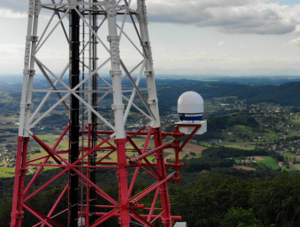ARSCliSys-Projekte
Radio-Okkultation und Klima
Satellitendaten und Bodendaten werden zusammen mit Klimamodell-Simulationen zum Studium von Klimavariabilität, Klimatrends und Wetter- und Klimaextremen eingesetzt. Im Brennpunkt stehen dabei der globale Klimawandel und eine Brückenbildung zum regionalen und lokalen Klima- und Umweltwandel in der Alpenregion.
ROMSAF4P/ROMSAF4Clim
Satellitenmessungen mittels Global Navigation Satellite System Radio Occultation (GNSS-RO) spielen eine Schlüsselrolle in den Nutzungsbereichen Wetter, Klima und Weltraumwetter. Alle von der European Organization for the Exploitation of Meteorological Satellites (EUMETSAT) betriebenen Satelliten in erdnahen Umlaufbahnen tragen GNSS-RO-Instrumente und werden das auch zukünftig tun. Auf diese Weise werden multiple GNSS-Signale genutzt und sind globale Wetter- und Klimabeobachtungen mittels GNSS-RO bereits bis in die 2040er Jahre hinein vorgeplant. Das Gesamtziel der Radio Occultation Meteorology Satellite Application Facility (ROM SAF) Fourth Continuous Development and Operations Phase (CDOP-4) von EUMETSAT, zu der auch das Wegener Center der Universität Graz beiträgt, ist die wirksame Nutzung dieser weltweiten Messungen.
Gefördert von DMI, FFG & Uni Graz.
Team (Wegener Center): Gottfried Kirchengast, Marc Schwärz, Erich Wappis, Florian Ladstädter, Josef Innerkofler
StratoClim – High-Quality Stratospheric Climate Data
Das Projekt erhöht die Datenqualität von den satellitengestützten Radiookkultations-(RO)-Daten in der mittleren und oberen Stratosphäre, indem Resteinflüsse wie zum Beispiel von der darüberliegenden Ionosphäre wirksam korrigiert werden. Basierend auf diesen aufbereiteten hochwertigen RO-Klimadaten werden troposphärische und stratosphärische Winde und ihre Zirkulationsmuster abgeleitet. Dank ihrer weltweiten Bedeckung, sehr guten Höhenauflösung und Langfriststabilität ermöglichen die RO-Klimadaten so neue Erkenntnisse zum Zusammenspiel von globaler Erwärmung und Zirkulationsänderungen in der Atmosphäre.
Team: Julia Danzer, Irena Nimac, Magdalena Pieler, Annika Reiter, Johannes Unegg
Cloud4Geo
Ziel des Projekts ist die Entwicklung einer in die European Open Science Cloud eingebundenen föderalen Cloud-Infrastruktur für die fächerübergreifende Nutzung von geowissenschaftlichen Daten in Forschung und Lehre. Das Projekt wird bestehende Speicher- und Datenverarbeitungskapazitäten am Erdbeobachtungsdatenzentrum, der Geosphere Austria, und dem Vienna Scientific Cluster mit Computersystemen der beteiligten Universitäten verknüpfen und entsprechend eines Konzepts für die gemeinschaftliche Nutzung von Satellitendaten, Bodenbeobachtungen und Computersimulationen erweitern. Der Zugang zu den Daten und deren Nutzung wird durch ein Single-Sign-On-Verfahren und neuen Open-Source-Software-Lösungen deutlich vereinfacht. Dadurch werden Wissenschafter:innen und Studierende in die Lage versetzt, mit großen Datenmengen interdisziplinär zu arbeiten. Dies ist die Basis für exzellente Forschung und Ausbildung in so wichtigen Querschnittsthemen wie dem Klimawandel und der Energiewende.
Team (Wegener Center): Gottfried Kirchengast, Armin Leuprecht, Heimo Truhetz, Martin Jury
WegenerNet
Mit über 150 Klimastationen in der Region Feldbach und 13 Stationen in der Gesäuseregion ist die Steiermark das Schwerpunktgebiet für ein Pionierexperiment der österreichischen und internationalen Klimaforschung: das WegenerNet.
Carbon Management/GCCI
Unsere Arbeit zu Carbon Management mit den Schwerpunkten institutionelles und öffentliches Carbon Management (ICM und PCM) ist ein innovativer Weg der Forschung und des Wissenstransfers zur Förderung der Einhaltung der Pariser Klimazielen.
CarbManage
Die Herausforderungen der Klimaziele des Pariser Abkommens auf allen öffentlichen, institutionellen und persönlichen Ebenen fair und effektiv meistern: CarbManage unterstützt Akteur:innen auf allen Ebenen (Public, Instituational, personal) bei der Erstellung von verlässlichen Treibhausgasbudgets samt entsprechendem Reduktionszielpfad.
Gesamtes Team; Kernteam: Gottfried Kirchengast, Julia Danzer, Stefanie Hölbling
Institutional Carbon Management (ICM) Uni Graz
Das Projekt implementiert die Klimaschutzziele der Universität und das Vorhaben einer Verringerung der Treibhausgasemissionen der Universität um rund zwei Drittel bis 2030 gegenüber einem Referenzbudget 2020. Die übergeordneten ambitionierten Umsetzungs-Meilensteine sind: Netto-Null Emissionen bis 2030 und Klimaneutralität bis 2040.
Kernteam: Gottfried Kirchengast, Julia Danzer, Stefanie Hölbling; gesamtes Team
CMTS-CAS
In diesem Projekt wird eine wissenschaftliche Fallstudie des APM-CAS zum Carbon Management (CM) für eine ausgewählte chinesische Region (Stadt Wuhan) unterstützt. Diese Fallstudie soll einen Startpunkt setzen, chinesische Regionen und Städte bei ihrem Beitrag zur Erreichung der Pariser Klimaziele mittels CM zu unterstützen. In diesem Zusammenhang stellt UNIGRAZ-WEGC die "Carbon Management Toolbox V9" sowie Support durch "Core Experts" ihres CM Teams zur Verfügung.
Team (Wegener Center): Gottfried Kirchengast, Julia Danzer, Stefanie Hölbling
Graz Climate Change Indicators (GCCI)
GCCI.Earth bietet zuverlässige Überwachungsinformationen aus der jüngsten Vergangenheit zusammen mit aktuellen Prognosen und Paris-konformen Zukunftsprojektionen über den kritischen Zeitraum des Klimawandels von 1960 bis 1990 und 2020 bis 2050. Dabei konzentriert es sich auf die Treibhausgasemissionen, die globale Klimaerwärmung und die Auswirkungen des Klimawandels in Form von Wetter- und Klimaextremen.
Gesamtes Team; Kernteam: Gottfried Kirchengast, Moritz Pichler
